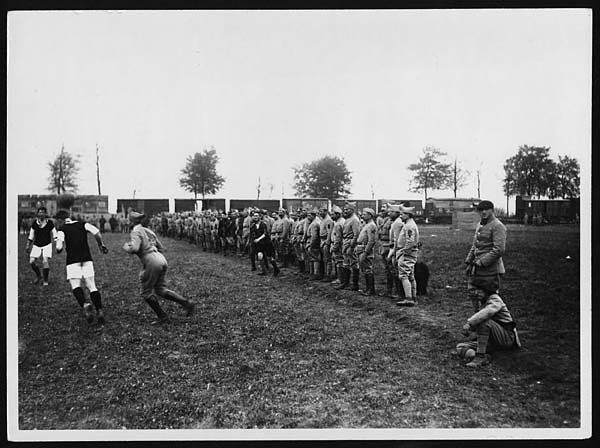.

Jogo de Futebol entre as selecções de Portugal e Itália, Porto, Portugal: photo by Mario Novais (1899-1967), 1928 (Biblioteca de Arte / Art Library Fundaçao Calouste Gulbenkian)
The
history of soccer is a sad voyage from beauty to duty. When the sport
became an industry, the beauty that blossoms from the joy of play got
torn out by its very roots. In this fin-de-siècle world,
professional soccer condemns all that is useless, and useless means not
profitable. Nobody earns a thing from that crazy feeling that for a
moment turns a man into a child playing with a balloon, like a cat with a
ball of yarn; a ballet dancer who romps with a ball as light as a
balloon or a ball of yarn, playing without even knowing he's playing,
with no purpose or clock or referee.
Play
has become spectacle, with few protagonists and many spectators, soccer
for watching. And that spectacle has become one of the most profitable
businesses in the world, organized not for play but rather to impede
it. The technocracy of professional sport has managed to impose a
soccer of lightning speed and brute strength, a soccer that negates joy,
kills fantasy and outlaws daring.
Luckily,
on the field you can still see, even if only once in a long while, some
insolent rascal who sets aside the script and commits the blunder of
dribbling past the entire opposing side, the referee and the crowd in
the stands, all for the carnal delight of embracing the forbidden
adventure of freedom.
Eduardo Galeano: from El fútbol a sol y sombra (Football in Sun and Shadow), 1995, English translation by Mark Fried, 1998

Jogo de Futebol entre as selecções de Portugal e Itália, Porto, Portugal: photo by Mário Novais, 1928 (Biblioteca de Arte / Art Library Fundaçao Calouste Gulbenkian)

Jogo de Futebol entre as selecções de Portugal e Itália, Porto, Portugal. Roquete (Guarda-redes), Jorge, A. Martins, J. Manuel, C. Alves, Pépe, Armando Marques, A. Silva, Martinho de Oliveira, Waldemar (3 golos), V. Silva (1 golo): photo by Mário Novais, 1928 (Biblioteca de Arte / Art Library Fundaçao Calouste Gulbenkian)

Jogo de Futebol, Lisboa, Portugal: photo by Mário Novais, c. 1920s (Biblioteca de Arte / Art Library Fundaçao Calouste Gulbenkian)

Jogo de Futebol, Lisboa, Portugal: photo by Mário Novais, c. 1920s (Biblioteca de Arte / Art Library Fundaçao Calouste Gulbenkian)

Jogo de Futebol, Lisboa, Portugal: photo by Mário Novais, c. 1920s (Biblioteca de Arte / Art Library Fundaçao Calouste Gulbenkian)

Jogo de Futebol, Lisboa, Portugal: photo by Mário Novais, c. 1920s (Biblioteca de Arte / Art Library Fundaçao Calouste Gulbenkian)

Jogo de Futebol, Lisboa, Portugal: photo by Mário Novais, c. 1920s (Biblioteca de Arte / Art Library Fundaçao Calouste Gulbenkian)

Jogo de Futebol, Lisboa, Portugal: photo by Mário Novais, c. 1920s (Biblioteca de Arte / Art Library Fundaçao Calouste Gulbenkian)

Incident in a big football match near the line between British and French forces on the Western Front in France. A large group of French troops watching from the touchline. British in black and white jerseys: photographer unknown, c. 1918 (National Library of Scotland)

Goalkeeper between the sticks. French soldier defending his goal of two wooden poles connected by a length of rope during a football match in France. Standing behind the goal is a group of mainly French soldiers: photographer unknown, c. 1918 (National Library of Scotland)

A football match. 3rd Horse versus 18th Lancers [France]: photo by H. D. Girdwood, 25 July 1915 (Girdwood Collection/British Library)

A football match. [9th] Gurkhas versus a Signal Company [St Floris, France]: photo by H. D. Girdwood, 23 July 1915 (Girdwood Collection/British Library)

A football match. [9th] Gurkhas versus a Signal Company [St Floris, France]: photo by H. D. Girdwood, 23 July 1915 (Girdwood Collection/British Library)

A football match. [9th] Gurkhas versus a Signal Company [of the Dehra Dun Brigade, at St Floris, France]: photo by H. D. Girdwood, 23 July 1915 (Girdwood Collection/British Library)

Crianças Tukuna jogando futebol, Benjamin Constant, Amazonas (Ticuna, Alto Solimoes, Amazonia): fotografia realizada pelo Prof. Silvio Coelho dos Santos, mantendo a denominação original do documento, junho de 1962 (Museu Universitário Oswaldo Rodrigues Cabral/Acervo Silvio Coelho dos Santos)


Futebol: photo by Victor Camilo, 8 March 2011





3 comments:
"organized not for play but rather to impede it"
That's really the whole nine yards, as they say.
Curtis
I'd want to echo Curtis here. Everything an industry now: culture; leisure; beauty.
Play happens in the unregarded corners (here's hoping).
Sometimes it's the unregarded corners where the ball takes the most unexpected bounces.
Than again, sometimes the business takes the air out of the ball.
Mario Novais captured the balletic aspect. On the Western Front, with the troops, footy was a stress relief.
Millionaire footballers were once, in the majority of cases, kids kicking a ball about sans supervision on a street somewhere.
There's something universal, a levelling-force, in a game so simple it can be and has been played world round with no equipment more sophisticated than an inflated scrap of rubber, leather or what you will.
The travesty of corporate sponsorship and the endless pimpology of FIFA won't change the fact that in Central and South America, this game speaks the language of the common people.
There are some happy Colombians on this planet tonight, and it's possible one or two of them aren't even drug lords.
Post a Comment